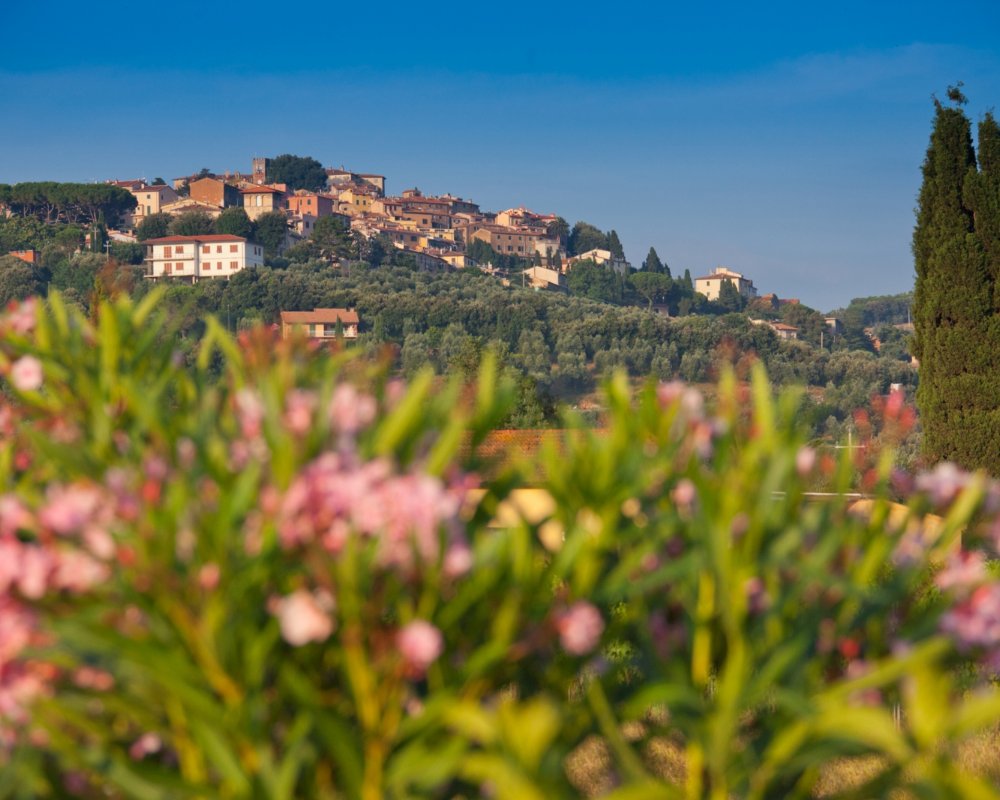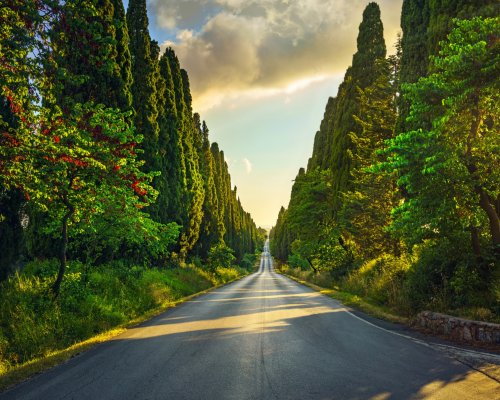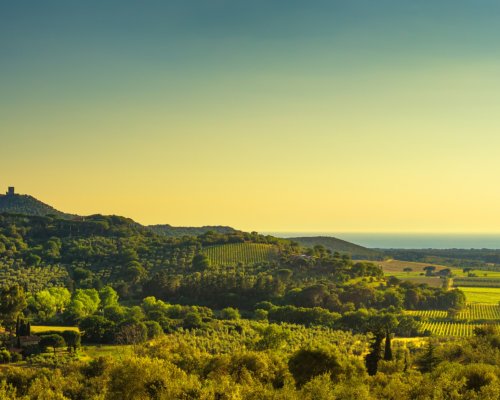


Strolling the Etruscan paths
Kilometres and kilometres of beaches surrounded by hills and plateaus in the shade of pine trees and cypresses. Forests of Mediterranean scrub and small villages dating to the Middle Ages that have become little oases of peace and nature. This is the Etruscan Coast, an area inhabited since Antiquity by the population that came before even the Roman Empire and was later absorbed by it.
The whole territory is an assortment of small villages, where the most precious archeological ruins rest in the shade of elegant medieval buildings in stone and brick, little Romanesque churches and country homes. And the best part? Their position, which, from high atop the hills, offers a view of the sea as if on a large natural terrace.
There are small towns, like Bibbona, Campiglia Marittima and Casale Marittimo, the poetic panoramas of Castagneto Carducci, and Bolgheri, with its famous cypress-lined avenue, classified as a national monument. This is the territory immortalized by the poet Giosuè Carducci, who in 1906 became the first Italian to win the Nobel Prize for literature.
Thanks to the short distances between the beaches and the hills inland, the Etruscan Coast is an ideal destination for immersing yourself in authentic Tuscany, perfect for a few days’ vacation in nature.
Our journey through the green and blue of the Etruscan Coast begins in Castagneto Carducci, a medieval village whose name is a tribute to one of the most important poets of the 19th century, Giosuè Carducci, who spent part of his life here. Arranged around the castle that once belonged to the Della Gherardesca family, the small village is a weave of paved alleys and little workshops, scenic terraces that jut out toward the sea and typical Italian restaurants offering the best of the illustrious local wine production.
In the historic centre, in addition to Palazzo Pretorio and the Church of San Lorenzo, you can visit Carducci’s former home, which today houses a museum dedicated to his life and work. You should also wander a little outside the centre, where you’ll be immersed in the Mediterranean scrub that surrounds the town. With the sea in the background, the lush and rolling hills are dotted with cypress trees that begin to bend toward the top, just like those flanking the famous cypress-lined avenue. From the parking lot in viale Pascoli, follow via di Sassetta toward the east, then take via di Bagnoli on the right and, to the left, via Nemorese.
The last road will lead you to the entrance to the hiking trail known as Antica, or ancient, via Campigliese, which takes you to the town of Poggio Tizzone, walking through forests of evergreens and small shrubs. Along the way, you can catch glimpses of open spaces where coal kilns where once located: in this area, there used to be a bustling industry tied to the exploitation of local wood for producing coal.
The ex-shelter used by coalmen in Poggio Tizzone is preceded by a fireproof lookout, located 430 metres up on a breath-taking balcony boasting a view of the Etruscan Coast. After a brief and restorative break, follow the ancient via Campigliese until you reach Capo di Monte, at 522 metres, from where you can begin the descent toward Piano dei Brizzi. Taking trail 1, you’ll come to the La Fiora crossroads, after which you can return to town by following trail n. 2.
Our journey through the green and blue of the Etruscan Coast begins in Castagneto Carducci, a medieval village whose name is a tribute to one of the most important poets of the 19th century, Giosuè Carducci, who spent part of his life here. Arranged around the castle that once belonged to the Della Gherardesca family, the small village is a weave of paved alleys and little workshops, scenic terraces that jut out toward the sea and typical Italian restaurants offering the best of the illustrious local wine production.
In the historic centre, in addition to Palazzo Pretorio and the Church of San Lorenzo, you can visit Carducci’s former home, which today houses a museum dedicated to his life and work. You should also wander a little outside the centre, where you’ll be immersed in the Mediterranean scrub that surrounds the town. With the sea in the background, the lush and rolling hills are dotted with cypress trees that begin to bend toward the top, just like those flanking the famous cypress-lined avenue. From the parking lot in viale Pascoli, follow via di Sassetta toward the east, then take via di Bagnoli on the right and, to the left, via Nemorese.
The last road will lead you to the entrance to the hiking trail known as Antica, or ancient, via Campigliese, which takes you to the town of Poggio Tizzone, walking through forests of evergreens and small shrubs. Along the way, you can catch glimpses of open spaces where coal kilns where once located: in this area, there used to be a bustling industry tied to the exploitation of local wood for producing coal.
The ex-shelter used by coalmen in Poggio Tizzone is preceded by a fireproof lookout, located 430 metres up on a breath-taking balcony boasting a view of the Etruscan Coast. After a brief and restorative break, follow the ancient via Campigliese until you reach Capo di Monte, at 522 metres, from where you can begin the descent toward Piano dei Brizzi. Taking trail 1, you’ll come to the La Fiora crossroads, after which you can return to town by following trail n. 2.
Our journey through these Etruscan lands continues the next day just a few kilometres to the south, in an area with immense nature-related value: the parks in the Val di Cornia. This region comprises six different protected sites (an archeological park, an archeological mines park, two coastal parks, a protected forest and a nature reserve), which unfold across the hills, dominated by the colours and scents of the Mediterranean scrub.
Head to San Carlo, a small hamlet of San Vincenzo immersed in the greenery and surrounded by hills. Probably inhabited as early as the Neolithic era, the hamlet is a short distance from the San Silvestro Archaeological Mines Park. Hidden amidst the vegetation, the park is weave of small paths crossing through a land known for its wealth of mineral resources laying beneath the earth, making it a mining point even in ancient times.
From San Carlo, follow the dirt roads and dive into the forest flanking a large quarry, looking for signs for trail n. 3. Walking alongside a stream, take trail 00 through a beautiful valley and head to the clearings on Monte Coronato. Our destination is further up though: the peak of Monte Romitorio, from where you can enjoy a stunning view that extends all the way to the sea. Afterward, go back the way you came, passing through the forest and walking across Valle delle Rozze until you arrive at the trail you took on your way here; from here you can return to the starting point.
Our journey through these Etruscan lands continues the next day just a few kilometres to the south, in an area with immense nature-related value: the parks in the Val di Cornia. This region comprises six different protected sites (an archeological park, an archeological mines park, two coastal parks, a protected forest and a nature reserve), which unfold across the hills, dominated by the colours and scents of the Mediterranean scrub.
Head to San Carlo, a small hamlet of San Vincenzo immersed in the greenery and surrounded by hills. Probably inhabited as early as the Neolithic era, the hamlet is a short distance from the San Silvestro Archaeological Mines Park. Hidden amidst the vegetation, the park is weave of small paths crossing through a land known for its wealth of mineral resources laying beneath the earth, making it a mining point even in ancient times.
From San Carlo, follow the dirt roads and dive into the forest flanking a large quarry, looking for signs for trail n. 3. Walking alongside a stream, take trail 00 through a beautiful valley and head to the clearings on Monte Coronato. Our destination is further up though: the peak of Monte Romitorio, from where you can enjoy a stunning view that extends all the way to the sea. Afterward, go back the way you came, passing through the forest and walking across Valle delle Rozze until you arrive at the trail you took on your way here; from here you can return to the starting point.
For a beautiful end to our journey through the lands of the Etruscans, head to Portiglioni, a small port to the south of Follonica, where you can catch a glimpse of the wild nature of the Grosseto Maremma. This leg of the trip winds through dense coastal vegetation and a spectacular stretch of the shore, embellished with alternating cliffs and beaches of fine sand.
Armed with your backpack, begin at the Puntone tourist port in the town of Portiglione, heading in the direction of trail n. 1. Our walk unfolds through the heart of the Mediterranean scrub, amidst forests and seaside views, before reaching trail n. 6 toward Cala Martina, an evocative beach with golden sand reflected in the crystalline sea. Near Cala Martina is a statue dedicated to Garibaldi: the hero of two worlds stopped right on this beach during his adventurous escape from Rome after the collapse of the Roman Republic.
From here, you can see your final destination in the distance, Cala Violina, visible beyond the promontory. You’ll notice the fine, clear sand when you get to the beach, made up mostly of small granules of quartz. The name of this beach takes its name from the mineral, which sounds like a violin when you walk barefoot on the sand. Continue your walk along trail n. 1 until you reach n. 2, followed by n. 3. You’ll eventually come to trail n. 6, which you’ll follow along the ridge until you get to, finally, trail n. 5. This will lead you back to the starting point.
For a beautiful end to our journey through the lands of the Etruscans, head to Portiglioni, a small port to the south of Follonica, where you can catch a glimpse of the wild nature of the Grosseto Maremma. This leg of the trip winds through dense coastal vegetation and a spectacular stretch of the shore, embellished with alternating cliffs and beaches of fine sand.
Armed with your backpack, begin at the Puntone tourist port in the town of Portiglione, heading in the direction of trail n. 1. Our walk unfolds through the heart of the Mediterranean scrub, amidst forests and seaside views, before reaching trail n. 6 toward Cala Martina, an evocative beach with golden sand reflected in the crystalline sea. Near Cala Martina is a statue dedicated to Garibaldi: the hero of two worlds stopped right on this beach during his adventurous escape from Rome after the collapse of the Roman Republic.
From here, you can see your final destination in the distance, Cala Violina, visible beyond the promontory. You’ll notice the fine, clear sand when you get to the beach, made up mostly of small granules of quartz. The name of this beach takes its name from the mineral, which sounds like a violin when you walk barefoot on the sand. Continue your walk along trail n. 1 until you reach n. 2, followed by n. 3. You’ll eventually come to trail n. 6, which you’ll follow along the ridge until you get to, finally, trail n. 5. This will lead you back to the starting point.